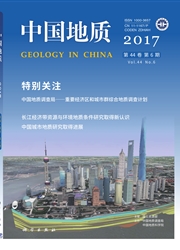

 中文摘要:
中文摘要:
云南个旧锡铜多金属矿床是世界级超大型矿床,个旧矿集区内与蚀变玄武岩有关的(似)层状铜矿床是其重要的矿床类型。该类型矿床的围岩玄武岩均发生蚀变,且蚀变强度与矿化关系密切。本文对个旧卡房矿化玄武岩中的金云母进行^40Ar-^39Ar同位素定年分析,得到其坪年龄为(85.49±0.63)Ma,等时线年龄为(85.62±0.42)Ma,反等时线年龄为(85.59±0.81)Ma,三者基本一致,代表了变玄武岩的蚀变年龄及同期矿化年龄,属于晚白垩世,可与个旧锡铜多金属矿床的成矿时代进行对比。
 英文摘要:
英文摘要:
The Gejiu polymetallic tin ore district in Yunnan Province is the largest tin deposit in the world,and the Kafang copper(tin) deposit is a component part of this ore district.The stratoid ore body of the Kafang copper(tin) deposit,closely related to meta-basalt,is characterized by enriched copper.The basalt has been altered and the alteration intensity is related to the copper mineralization.This paper presents a new 40Ar-39Ar phlogopite age for the meta-basalt in the Kafang tin-copper deposit in order to constrain the timing and duration of the alteration of basalt and the mineralization.Phlogopite yielded 40Ar-39Ar plateau age of 85.49±0.63 Ma,isochronal age of 85.62±0.42 Ma,and inverse isochronal age of 85.59±0.81 Ma.These ages are substantially consistent with each other,pointing to late Cretaceous.These results are coincident with the data obtained from the Gejiu polymetallic tin-copper deposit.
 同期刊论文项目
同期刊论文项目
 同项目期刊论文
同项目期刊论文
 Petrogenesis of the Xihuashan granites in southeastern China: Constraints from geochemistry and in-s
Petrogenesis of the Xihuashan granites in southeastern China: Constraints from geochemistry and in-s Ages and geochemistry of Laojunshan granites in southeastern Yunnan, China: implications for W-Sn po
Ages and geochemistry of Laojunshan granites in southeastern Yunnan, China: implications for W-Sn po SHRIMP U-Pb (zircon), Ar-Ar (muscovite) and Re-Os (molybdenite) isotopic dating of the Taoxikeng tun
SHRIMP U-Pb (zircon), Ar-Ar (muscovite) and Re-Os (molybdenite) isotopic dating of the Taoxikeng tun Age and Geochemistry of Granites in Gejiu area, Yunnan province, SW China: Constraints on their petr
Age and Geochemistry of Granites in Gejiu area, Yunnan province, SW China: Constraints on their petr Petrogenesis and geodynamic implications of Gejiu igneous complex in the western Cathaysia block, So
Petrogenesis and geodynamic implications of Gejiu igneous complex in the western Cathaysia block, So Timing of the formation of the Tianhuashan Basin in northern Wuyi as constrained by geochronology of
Timing of the formation of the Tianhuashan Basin in northern Wuyi as constrained by geochronology of Granite, gabbro and mafic microgranular enclaves in the Gejiu area, Yunnan Province, China: a case o
Granite, gabbro and mafic microgranular enclaves in the Gejiu area, Yunnan Province, China: a case o 期刊信息
期刊信息
